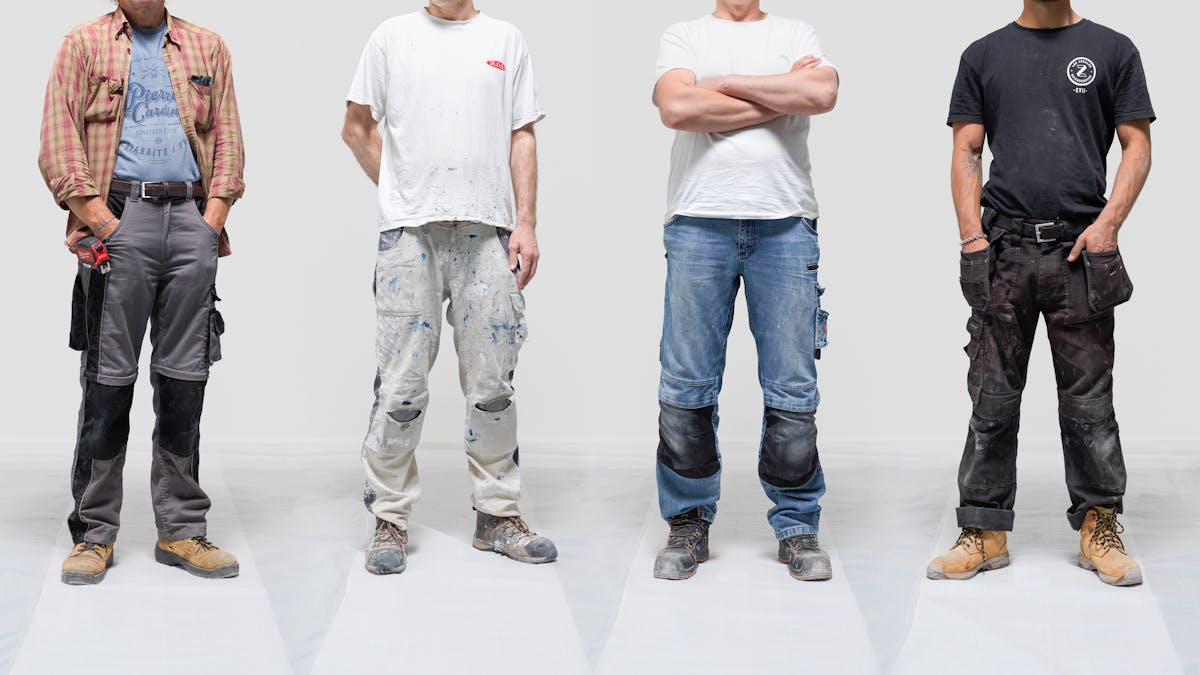After years of dressing extravagantly, Niven Govinden returned to workwear and the ‘butch drag’ aesthetic of boiler suits, denim cut-offs and work boots. These clothes still reflected his identity and showed one fellow customer at the builders’ caff that they exist on the same spectrum.
Butch drag in the builders’ caff
Words by Niven Govindenphotography by Benjamin Gilbertaverage reading time 5 minutes
- Article

I’m standing at the counter at the builders’ caff waiting to be served. Next to me is a burly dude waiting for his teas. Both of us are wearing paint-splattered clothing, I notice: him in a navy sweatshirt, with the name of his firm embroidered on the chest, his jeans also covered with paint and plaster. My outfit is more pristine: a work jacket from Japan in white denim, marked with purple paint that some poor designer took hours agonising over. From a distance we look the same… don’t we?
I think of another time in the same builders’ caff, when I’m wearing a padded black boiler suit from Supreme, fitted on the chest, and ludicrously baggy on the legs. Rave central. There are two other men sitting at a table wearing navy boiler suits. We match… don’t we? Why, then, is this anything but convincing?
Clothes that I think make me look masculine:
- denim cut-offs
- work boots
- shell-suit jacket.
Clothes that look completely different on other men:
- denim cut-offs
- work boots
- shell-suit jacket.
Queering the male wardrobe
This isn’t about labels, or a style – well, maybe a little about style – but more an observation on how I’ve returned to workwear over the past few years, and how comfortable it makes me feel: boiler suits, French chore jackets, lumberjack shirts, heavy boots. I tell myself that I’m no longer interested in dressing up, though this is, of course, dressing up of another kind: butch drag, fetishising labels and cuts the way I used to with more outrageous dressing back in the day, when clothes were nothing less than an event. I’m thinking of head-to-toe BOY-era stars and stripes as a young teen, to Westwood bondage and pirate ensembles, capes, fake-fur coats, customised everything. I was never shy of colour, print, tie-dye or appliqué. It was a lot.
In my novel ‘This Brutal House’, exploring vogue houses and ball culture, I wrote about the work that went into projecting butch, banjee and executive realness, and there’s definitely something of that at play here. More explicitly, it’s a nod to queer fashion’s knowing take on masculinity: how wearing this stuff puts you in a certain mould; how it’s a piss-take on the notion of ‘passing’, but also how this gear can help you pass, if you need to for reasons of safety, ego or lack of imagination (no judgement).
I tell myself that I’m no longer interested in dressing up, though this is, of course, dressing up of another kind.

I’m swishing around in my French chore jacket, picked up from a vintage store in Paris for €10, in love with its fit and practicality – pockets for everything. It is utility and masculinity in one garment. I practically live in it. The lengths I would have to go to to find another jacket as perfect as this one – it’s not just how it looks, but how it appears when I wear it, what I project.
French chore jacket, shorts, an impractically high-soled trainer, oversized glasses: this is the outfit I keep returning to, because it tells you something of my personality without the anxiety. I still look and feel queer wearing this outfit; aware that I’m still being appraised for looking the same but different – though crucially, in a way that’s questioning rather than hostile.
Navigating masculine spaces
This is what I mean: I’m thinking about the masculine spaces we constantly navigate and internally negotiate with as queer people; how a process of unspoken decision-making regarding our safety impacts on how we use public space, and the spaces we choose to fill. And that’s before you add the micro-aggressions towards people of colour into the mix; the levels to this, and how it impacts on your daily life, simply by walking down the street in what you choose to wear.
When I’m thinking about the masculine spaces that apply to my own life, I’m referring to the barber, the pub, the garage when you need to get the car tyres changed, the seconds-long appraisal of the workman you’ve allowed into your home. It’s not so much about fitting the norms regarding masculinity – honey, I don’t give a fuck; I usually answer the door in a daywear kimono – it’s more an understanding that our visions of masculinity, such as that moment standing at the builders’ caff counter, do not match. The question is how to bridge the gap without acknowledging this on either of our parts.
More: Can there ever be a simple truth when it comes to gender identity?
I buy a vintage Adidas shell-suit jacket in a Brussels flea market: dark green and white, cut with a thick black chevron front and back. I wear it with shorts for most of my week away, as summer folds into a more unsettled season, and convince myself that I look vaguely athletic. It’s another ageing raver’s uniform, of course, but all I see is the swag of it, its inherent toughness. My friends don’t take me seriously in it, but wearing it a few weeks later down the builders’ caff, someone asks me if I’m working on the massive office-block renovation around the corner.
To those who are ‘masc’ obsessed, this would feel like a vindication, though in my case, it feels more like an olive branch, an acknowledgement that we exist on the same spectrum. “Not today,” I say, pointing to crepe-soled boots, “they weren’t feeling my high heels.” And the dude, to my surprise, roars with laughter and buys my tea.
About the contributors
Niven Govinden
Niven Govinden is the author of five novels, including ‘Black Bread White Beer’, which won the Fiction Uncovered Prize, and ‘All the Days and Nights’, which was longlisted for the Folio Prize and shortlisted for the Green Carnation Prize. His latest book ‘This Brutal House’ (Dialogue Books) has been shortlisted for the 2019 Gordon Burn Prize.
Benjamin Gilbert
Ben is a senior photographer for Wellcome. He is happiest when telling stories with his photographs, whether that be the health implications of rural-to-urban migration in India, or the dedication of the workers who power the NHS.

